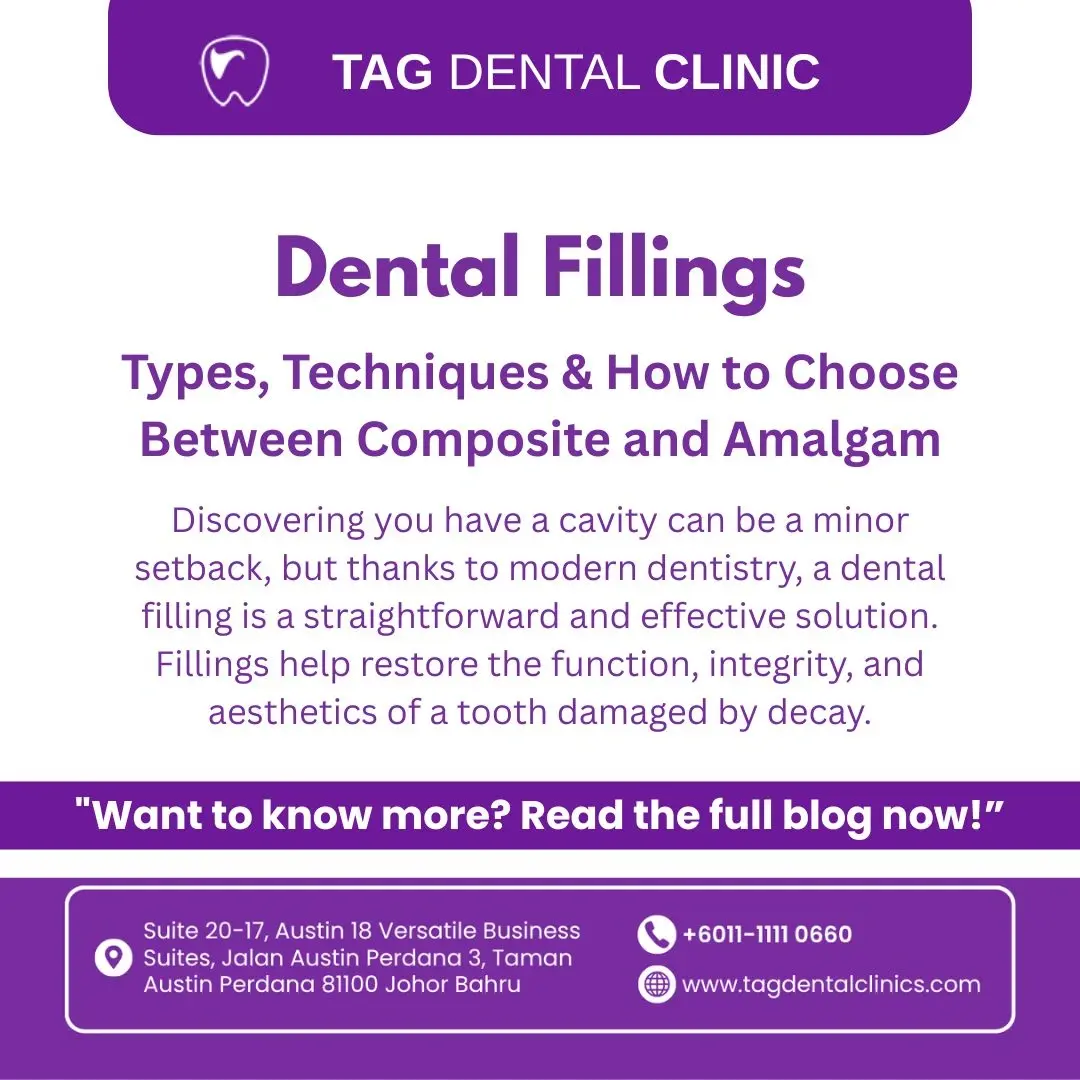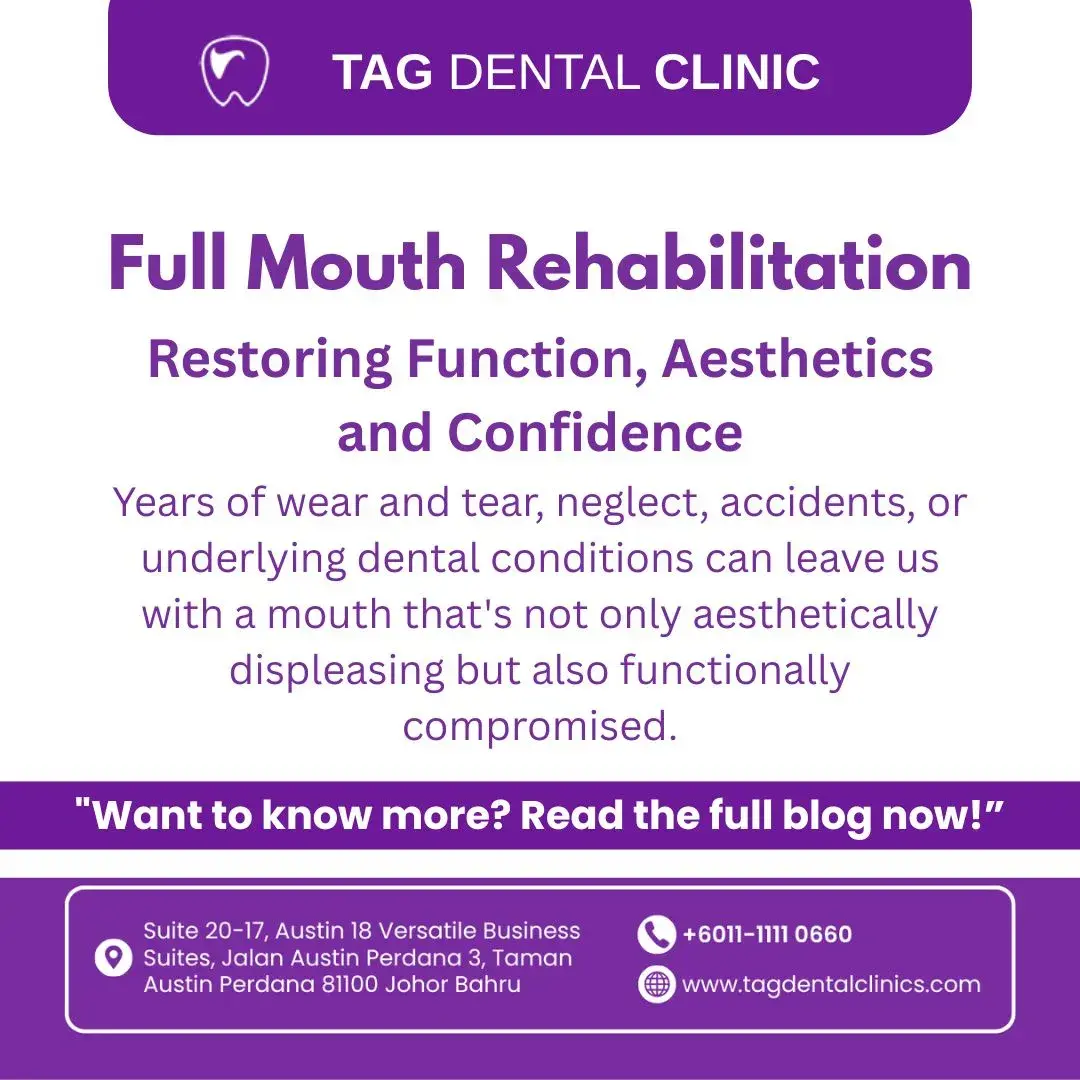Dental Fillings in Johor Bahru
Table Of Content

Types, Techniques & How to Choose Between Composite and Amalgam Dental Fillings
Discovering you have a cavity can be a minor setback, but thanks to modern dentistry, a dental filling is a straightforward and effective solution. Fillings help restore the function, integrity, and aesthetics of a tooth damaged by decay. However, with various materials available, how do you choose the right one?
At TAG Dental Clinic in Johor Bahru, we guide our patients through the best options for their oral health and lifestyle. Understanding the types of dental fillings, their techniques, and key considerations like cosmetic preferences, cost vs durability, and post-filling care will empower you to make an informed decision for your smile.
What is Dental Filling?

A dental filling is a restorative material used to fill a cavity (a hole in the tooth caused by decay) after the decayed portion has been removed. Its primary purpose is to:
- Stop the progression of decay.
- Restore the tooth's original shape and function.
- Prevent bacteria from entering the tooth, which could lead to further damage or infection.
Types of Dental Fillings at TAG Dental Clinic

In modern dentistry, the two most common materials for dental fillings are composite resin and amalgam. Each has distinct characteristics:
1. Composite Fillings (Tooth-Colored / White Fillings)
- Material: Made from a mixture of acrylic resin and finely ground glass-like particles.
- Aesthetics: This is their main advantage. They are custom-matched to the natural shade of your tooth, making them virtually invisible. This makes them a popular choice for cosmetic preferences in adults, especially for front teeth or other visible areas.
- Technique: The material is directly bonded (chemically adhered) to the tooth structure, often requiring less removal of healthy tooth structure compared to amalgam. It's cured (hardened) with a special light.
- Durability: Good for small to medium-sized cavities and areas not subjected to extreme chewing pressure. While durable, they may not last as long as amalgam in very large cavities on molars.
- Cost: Generally a higher upfront cost than amalgam fillings due to the material and more intricate bonding procedure.
2. Amalgam Fillings (Silver Fillings)
- Material: An alloy of mercury (around 50%), silver, tin, and copper.
- Aesthetics: Their silver/metallic appearance makes them quite noticeable, which is often a drawback for cosmetic-conscious adults.
- Technique: Amalgam is packed into the prepared cavity and hardens rapidly. It relies on mechanical retention, meaning the tooth often needs to be shaped in a way that locks the filling in place, which might require more removal of healthy tooth structure.
- Durability: Exceptionally strong, durable, and resistant to wear, making them an excellent choice for large cavities in the back molars where chewing forces are greatest. They have a proven track record of lasting many years.
- Cost: Generally more affordable than composite fillings.
- Safety: The use of mercury in amalgam fillings has raised concerns for some, but major dental and public health organizations worldwide (like the ADA, WHO) confirm their safety and effectiveness for dental restorations, noting that the mercury is bound within the alloy and released in negligible amounts.
Minimally Invasive Preparation Methods in Johor Bahru

At TAG Dental Clinic, we embrace minimally invasive dentistry. This philosophy aims to preserve as much healthy tooth structure as possible. For composite fillings, the bonding technique often allows for less drilling, as the material adheres directly to the tooth. For very small cavities, advanced techniques like air abrasion or even some lasers can be used to remove decay with minimal or no drilling and often without the need for anesthesia. This approach reduces discomfort and helps maintain the tooth's natural strength.
How to Choose: Composite vs. Amalgam (Key Decision Factors)

Deciding between composite and amalgam involves weighing several factors, and your dentist at TAG Dental Clinic in Johor Bahru will help you make the best choice:
- Cosmetic Preferences: If you prioritize aesthetics and an undetectable filling, composite is the clear winner, especially for visible teeth.
- Location of the Cavity: For front teeth, composite is almost always preferred. For molars subjected to heavy biting forces, amalgam has historically been chosen for its strength, though modern composites are increasingly robust.
- Size of the Cavity: Small to medium cavities are well-suited for composite. Very large or deep cavities, especially in molars, might benefit from the superior strength and sealing ability of amalgam or even require an inlay/onlay or crown.
- Cost: Amalgam is generally more budget-friendly upfront.
- Durability vs. Aesthetics: This is often a key trade-off. Amalgam typically boasts a longer lifespan for large posterior restorations, while composite offers unmatched aesthetics.
- Your Dentist's Recommendation: Based on the specific characteristics of your tooth, the size and location of the cavity, and your overall oral health, your dentist in Johor Bahru will provide expert advice.
The Dental Filling Procedure at TAG Dental Clinic

The process for a dental filling is generally straightforward:
- Numbing: The area around the affected tooth is numbed with local anesthesia to ensure a pain-free experience.
- Decay Removal: The decayed or damaged portion of the tooth is carefully removed using specialized dental instruments.
- Preparation: The cavity is cleaned and prepared to receive the filling material. For composite, a bonding agent is applied.
- Filling Placement: The chosen filling material is carefully placed into the cavity.
- Shaping & Curing: The material is shaped to match the natural contours of your tooth. For composite, a special light is used to harden (cure) the material.
- Polishing: The filling is polished to ensure a smooth surface and proper bite alignment.
Post-Filling Care for Optimal Longevity

Proper care after your filling ensures its longevity and your comfort:
- Temporary Sensitivity: It's common to experience some sensitivity to hot, cold, or pressure for a few days or weeks, especially with composite fillings.
- Avoid Chewing: Avoid chewing on the filled tooth until the numbness from the anesthetic wears off, to prevent accidentally biting your cheek or tongue.
- Good Oral Hygiene: Continue your diligent routine of brushing twice a day and flossing daily to prevent new decay around the filling.
- Avoid Hard/Sticky Foods: Be cautious with very hard or sticky foods immediately after getting a filling, especially with composite, to allow it to fully set.
- Regular Dental Check-ups: Continue your routine visits to TAG Dental Clinic in Johor Bahru every six months. Your dentist will monitor the condition of your fillings and overall oral health.
Frequently Asked Questions (FAQs) about Dental Fillings

The lifespan varies: Amalgam can last 10-15+ years; composite typically 5-10 years, depending on location, size, and oral habits.
2. Do fillings hurt?The procedure itself is pain-free due to local anesthesia. You might experience some temporary sensitivity afterward, which usually subsides.
3. Can I replace my old amalgam fillings with composite?Yes, many patients choose to replace old amalgam fillings for aesthetic reasons or if the amalgam filling is failing. Discuss this with your dentist.
4. What is sensitivity after a filling?It's common for teeth to be sensitive to temperature or pressure after a filling due to irritation of the nerve. It usually resolves on its own.
5. Can a filling get a cavity under it?Yes, secondary decay can occur around the edges of a filling if bacteria leak underneath. Regular check-ups help detect this early.
6. Is mercury in amalgam fillings dangerous?Major dental and public health organizations have extensively studied amalgam and concluded it is safe and effective for dental restorations, as the mercury is bound within the alloy.
7. How do I know if I need a filling?Often, you won't feel it until the cavity is large. Regular dental check-ups with X-rays are the best way to detect cavities early.
8. Can I choose the type of filling I want?Yes, after discussing the pros and cons of each material with your dentist, you can make an informed choice based on your needs and preferences.
9. What is the "white spot" on my tooth after a composite filling?This is likely an etching mark or slight discoloration from the bonding agent used with composite, which often blends in over time or can be polished.
10. How soon can I eat after a filling?For composite fillings, you can typically eat as soon as the numbness wears off. For amalgam fillings, dentists sometimes recommend waiting a few hours to allow them to fully harden.
Don't let dental decay compromise your smile or your health. Dental fillings are a straightforward way to restore health and comfort.

At TAG Dental Clinic in Johor Bahru, we are committed to providing high-quality, personalized dental care, helping you choose the best filling solution for your needs.
Ready to address your cavities? Schedule a consultation at TAG Dental Clinic in Johor Bahru and restore your healthy, confident smile!





